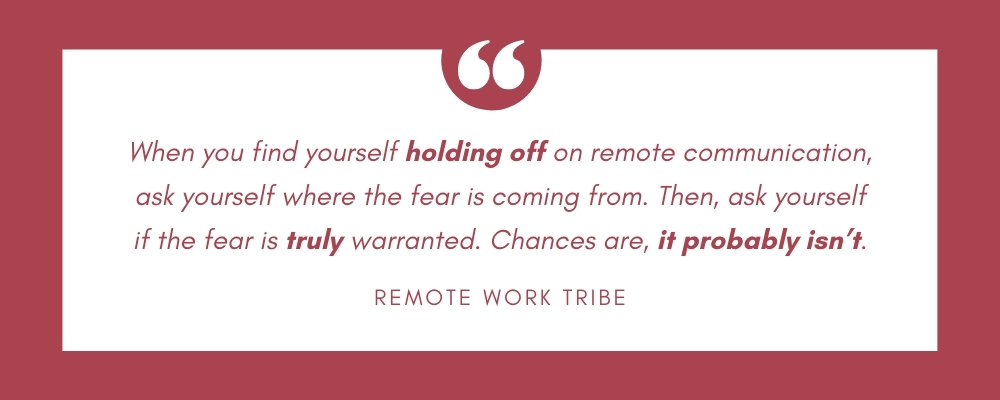When it comes to team-wide remote communication, there are a ton of nuances that can inform a more productive (and enjoyable) working relationship. When these nuances go ignored, the intricacies of team-wide remote team communication can ultimately complicate or stall overall company effectiveness. As a remote manager or founder, it’s essential to keep these intricacies front of mind when delivering new projects or initiating a difficult conversation.
Let’s take a look at the nuances involved with remote manager communication, remote team member communication, and why certain conversations can be a bit more tricky while on a remote or hybrid team.
Remote Communication Nuances for Managers and Founders
So, what exactly do the intricacies involved with team-wide remote communication entail? For one, the implications of less face-to-face conversations and increased text messages create room for doubt in communication. Secondly, there are certain best practices that are unique to either remote team managers or individual employees.
First off, let’s explore the best practices for remote managers.
One of the biggest issues remote team managers face when it comes to communication is format and cadence. How often should you engage with employees? When should you opt for an audio call instead of a video chat, or other tool in your remote communication stack?

Truthfully, the answers might surprise you.
Research published by the Academy of Management suggests, “members of a team should avoid thinking of message-based communication, like email and texting, as asynchronous, with everyone simply sending messages to one another whenever they feel like it.” Instead, they’ve found that the hallmark of successful teams is “burst communication.”
Burst Communication is Preferred
Burst communication is a colorful way of describing periods of high activity on teams. According to researchers, bursts of rapid-fire communications, with longer periods of silence in between, allow each team member to reach their own peak productivity.
According to the Academy of Management, “Those silent periods are when team members often form and develop their ideas — deep work that may generate the next steps in a project or the solution to a challenge faced by the group. Bursts, in turn, help to focus energy, develop ideas, and achieve closure on specific questions, thus enabling team members to move on to the next challenge.”
To adopt a burst communication style, remote managers should align team schedules in a way that allows for short periods of communication when everybody can respond rapidly and attentively. If your team is spread across the globe, this means finding a “happy medium,” when it’s not too late for members in one country or the crack of dawn for others. Ideally, pick a time when each employee will be in front of their computers already, to encourage rapid communication.

The easiest way to do this is to schedule blocks of time when remote employees are open for meetings. In this way, team members won’t feel like they’re being hounded for a call or like they need to restructure their daily schedule.
Recent technology makes it a breeze to facilitate opportunities to sync with others organically, such as shared calendars in company emails. These shared calendars can cue a manager when someone is scheduled in a meeting or personal obligation and is not available, or is ready to engage in remote communication.
Not Every Call Needs to Be a Video Call
Before hopping straight into a video call to participate in a remote communication burst, remember that video conferences have their time and place. In other words, not every call needs to be a video call. If your team is currently on more than five video calls per day — and doesn’t work directly in sales — that’s simply way too much.
Conversations involving emotional nuance, such as firing an employee or supplying a raise, warrant the visual cues that come with video calls. However, recent insight has shown that in some instances, not having access to visual cues — such as on an audio-only call — actually increases equality and productivity in speaking time.
Face-to-face, voice inflections and facial expressions cue other team members when it’s appropriate to speak without interrupting. But waiting for a cue in facial expressions can create a lag in response time, as other team members wait for a teammate to finish speaking. In recent research, it was found that in certain cases, added video reduces the equality in speaking time — which, in turn, reduces the collective intelligence and engagement in your remote communication.

What does this mean for remote managers? It’s often a good idea to prioritize audio calls over video conferences during task-focused conversations. When discussing upcoming tasks or projects, opt for an audio call, so participants can focus on collaboration. And of course, when having sensitive conversations, go ahead and turn on that camera for emotional cues.
Remote Communication Nuances for Individual Employees
So, how can individual employees also abide by remote communication best practices? For starters, all team members must make a conscious effort to stay on the same page as other teammates. So, for instance, if a remote team manager is organizing a time for burst communication, each individual contributor should do their part in communicating their ideal window.
For burst communication to work, there must be time for each individual contributor to focus on individual task work. However, this can be a challenge if team members are also managing home-schooling, childcare, or nurturing other family members — especially if they do not have access to a dedicated workspace. With so much of the world transitioning into remote work due to COVID-19, it should be anticipated that individual contributors may be also juggling these factors while navigating remote communication.
Encourage Individual Contribution
With the above being said, it is still the responsibility of each individual contributor to communicate a time in their schedule that works best for them. For example, if team members recognize that they tend to be more responsive to one another at certain times, it’s best if they start to shift their schedules and focus on their shared work at those times so that they can then iterate quickly on tasks.

Once coordinated, contributors engaged in burst communication can fall naturally into engagement patterns with fellow employees and management. To optimize remote communication, contributors should strive to make each message as focused as possible. So, instead of sharing a novel-length email that touches on three completely separate topics, send three individual emails when necessary.
The fewer the number of ideas involved in a given message, the easier it is to go into more depth and have a back-and-forth exchange about each one. With more targeted conversations, it can also be easier to segue into those less-than-pleasant topics in team-wide remote communication.
The Nuances of Difficult Conversations in Remote Communication
Speaking of “less-than-pleasant topics,” why do we avoid difficult conversations at work anyway? What is it about certain conversations that just make us suddenly recoil in fear? In our experience, the answer lies in four arenas:
- A lack of time for “dealing with” complicated issues
- A fear about the outcome of the issue
- A preconceived notion about how the conversation due to previous experiences
- A measure of self-defense to steer clear of awkward or painful moments
Let’s take a deeper look at each of these reasons — and provide some guidance for your more difficult remote communication.
1. Lack of Time
As a manager, how often do you hear, “I don’t have time to tackle this today.” Well, while that might work for last month’s budget report, that excuse can’t fly for difficult remote communication. What’s important to recognize is that whatever isn’t done today, will only lead to more headaches (and anxiety) tomorrow. And in some cases, like terminating an employee, extending the situation will only make matters worse.
You cannot and should not “put off” or delay matters that are important to the livelihood and success of your company. Eventually, the consequences will catch up to you — and the damage may be worse the longer you wait. Think of the last time you put off taking your car to the repair shop: Suddenly the issue snowballed and it ended up costing you triple the amount to fix.
Instead, mark a time on your calendar as soon as possible. Creating a visual cue on your daily to-do will help make the conversation impossible to avoid, so you can get to it and get through it.
2. Fearful of an Outcome
There can be a degree of fear behind uncomfortable conversations, both for the manager and the employee. Even when partaking in positive remote communication with an employee, it’s normal to get some butterflies every now and again — especially if you’re a more introverted person to begin with.
But problems start when you begin to fear the repercussions of the situation or what the remote employee or their teammates may think of you. For instance, as a manager you may fear not being liked if you have to make an unpopular decision.

In these moments, stop and tell yourself one thing: You would not be having this conversation if you didn’t have to. For both good news and bad news! If you’re terminating an employee, it should only be because the individual in question had already received multiple warnings. And if you’re giving a raise, it’s because the employee deserved it; the opinion of others shouldn’t negate that.
Next time you find yourself holding off on that all too important remote communication, ask yourself where the fear is coming from. Then, ask yourself if the fear is truly warranted. Chances are, it probably isn’t.
3. Jaded by Previous Experiences
Experiencing a rough moment in your own past after having a difficult conversation can leave long-lasting imprints in your subconscious. The thought of having another difficult conversation can trigger those old feelings. For example, if you were previously laid off due to company-wide cutbacks, you might be frightened to lay off one of your own employees, in fear of leaving them with the same bad impression you were left with.
While you may not even realize you’re tapping into these memories, the negative emotions that come with them can rear their head when you’re faced with a confrontation. If this sounds familiar, it’s important to recognize why this is happening. What conversation is still playing on loop in the back of your mind?
Address that moment head on and find ways to heal that part of your past. Not only can those negative emotions negatively impact you, but they can have lasting repercussions on your team. It’s key to remove any barrier from effective remote communication, including uncomfortable past experiences.
4. Measure of Self-Defense
In addition to a fear of previous experiences, some managers feel that difficult conversations can drain their energy. It can take some work to mentally prepare yourself to go through the process of having an uncomfortable conversation. Add that mental tax to the burden of having the actual conversation and it’s no wonder some managers would rather put up a wall of self-defense.
A great example of this is giving constructive criticism. Some managers or founders work themselves up so much before providing feedback, worried about how to strike an even balance between criticism and guidance. They often wrack their brains about how the message should be delivered, and whether or not they’re being overly critical.

In moments such as these, bear in mind that we all go through difficult situations. But we all cannot hide from them. Similar to those who run from difficult conversations due to lack of time, remember that stretching out the moment will only cause YOU more mental burden in the long-run.
So, go ahead and just get the moment over with. Your brain — and your team — will thank you.




[…] learn more about how to navigate those conversations you’re avoiding? Check out our latest post, The Intricacies of Team-Wide Communication, today! But before you go, check out what else Twitter was up to this […]
[…] Amy hits the nail on the head by highlighting management as a key part of remote work gaining momentum. Without the “desk watch” some managers are accustomed to, a proper transition to remote work will be fueled by managers who can understand the intricacies of dispersed teams. […]